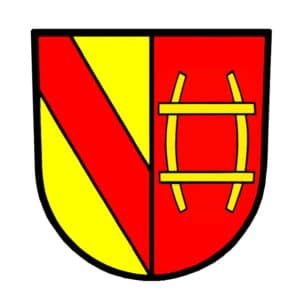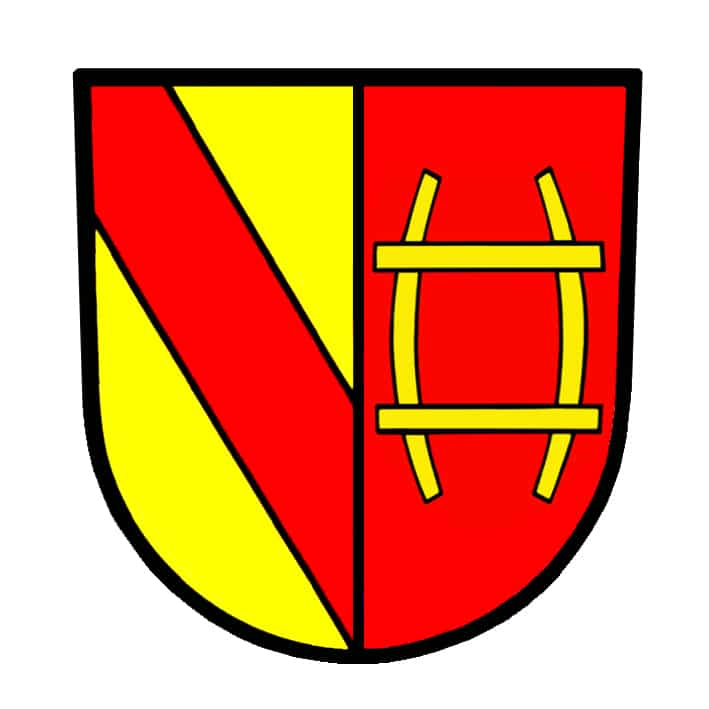Rastatt is a city in Baden-Württemberg , about 22 kilometers southwest of Karlsruhe and about twelve kilometers north of Baden-Baden . It is the district town and largest city in the Rastatt district and forms a middle center for the surrounding communities.
The urban area of Rastatt consists of the core town and the districts of Niederbühl, Ottersdorf, Plittersdorf, Rauental and Wintersdorf.
excerpts from the municipality's website about the history of Rastatt :
From the Bronze Age to the 16th century
The settlement in the Rastatt district dates back to the Bronze Age.
The town of Rastete, conveniently located at an important river crossing, was first mentioned at the end of the 11th century. King Ruprecht granted the town market rights in 1404. The market developed into a preferred trading place for Alsatian wine. That's why the city of Rastatt has the wine ladder in its coat of arms .
The War of the Palatinate Succession in 1689 completely destroyed the market town. This was followed by the reconstruction of the city as the new residence and model city of Margrave Ludwig Wilhelm of Baden-Baden.Rastatt in the 17th and 18th centuries
Rastatt Residential Palace is slightly elevated above the city. High up on the roof shines the golden figure of Jupiter, popularly known as the “Golden Man”. It symbolizes the builder of the castle: Margrave Ludwig Wilhelm of Baden-Baden , who ruled from 1677 to 1707. In 1700, he was the first of the princes on the Upper Rhine to decide to build a modern baroque residence instead of the hunting lodge he had already started.
The palace is one of the earliest German examples of imitating the Versailles system. The glorification of the sovereign through architecture, painting and stucco is particularly easy to understand here. The margrave displayed his military merits in the castle - as an imperial general he had been successful in the Great Turkish War and was thus nicknamed “Türkenlouis”. In 1705 the family moved into a side wing of the castle - but the margrave could hardly enjoy his new residence.
Ludwig Wilhelm died in January 1707. Now his wife Sibylla Augusta ruled the country - for twenty years as regent in place of their still underage son Ludwig Georg. Sibylla Augusta completed the interior design of the castle and added other buildings to the residence.
pleasure palace, Favorite , a few kilometers away, still bears witness to her extraordinary taste in art. Both castles were not destroyed in the Second World War.
In 1714, Rastatt was the place where European history was written. The Peace of Rastatt the Spanish Succession , in which all major European powers had been involved since 1701. The castle provided the stage for the four-month peace negotiations that culminated in the Peace of Rastatt.
Rastatt was the residence of the Margraviate of Baden-Baden from 1705 to 1771. important baroque buildings that still shape Rastatt's cityscape today were built in this era . After the Baden-Baden line died out in 1771, the margraviate fell to the Protestant Baden-Durlach. The new state government under Margrave Karl Friedrich took various initiatives to promote Rastatt's economy. These include the organization of the Rastatt Congress , which met in the former residential palace from 1797 to 1799, as well as the founding of a wagon factory. The court and later the Middle Rhine district government were based in Rastatt. The city developed into a wealthy administrative center in the first half of the 19th century.
Federal fortress and Baden Revolution
The construction of the Rastatt Federal Fortress since 1842 meant a turning point in the city's development. The cityscape and life in the city are changing fundamentally. The authorities move away, and economic development is now very limited and heavily dependent on the military.
In 1849, Rastatt became the central scene of revolutionary events during the Baden Revolution . From July 1st to 23rd, over 5,500 men of the Revolutionary Army were trapped in the fortress, who finally capitulated to the Prussian besiegers. The federal fortress of Rastatt became a symbol of the Baden revolution. For the Prussians it was the place of triumph, for the Baden democrats it was the place of defeat. With the consolidation since 1890, the ramparts fell and Rastatt became an open city again. New industrial settlements come to Rastatt and bring prosperity to the city.
Our veterinary practice in Malsch is approx. 10.1 km from Rastatt and can be easily reached via the B3.


